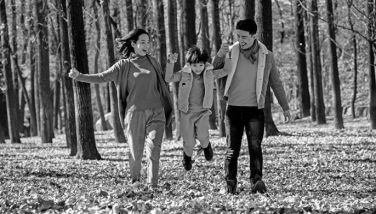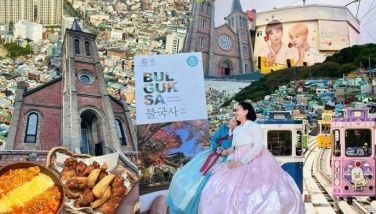Rishab’s rapture of phantasms

Memory’s such a trickster. I could’ve sworn that I first met the outstanding Cordillera-based artist Roger “Rishab” Tibon sometime in the mid-1980s when I frequented Baguio. I also erroneously associated that time with the incipient state of the Tam-Awan Village, which I recall was principally set up by BenCab, who was yet to become our eminently acclaimed National Artist for the Visual Arts.
But it turns out that Rishab didn’t move to Baguio until the ’90s, and Tam-Awan Village was set up late in that decade. I do have this memory of him and Ben practicing arnis on that concrete mini-plaza by the artists’ display center and coffeeshop — in what would become a haven of a village of transplanted Cordillera huts. I also recall the young Jordan Mangosan starting out on his “solar paintings” — with images burned into wood panels by means of a magnifying glass.
Of course those days must have conflated with the time when another buddy, Santiago Bose, organized the Baguio Arts Guild, which became a dynamic organization of Baguio-based artists that successfully networked with their counterparts in Puerto Galera, Negros Occidental, the rest of the Visayas and Mindanao. They were all eventually hosted at the annual Baguio Arts Festival, which also saw the participation of Manila-based poets comprising the Philippine Literary Arts Council.
Santi Bose founded the guild in 1987 and served as its first president, as he did again in 1992, by which time the Baguio International Arts Festival had been established primarily through his efforts. The yearly fest started in 1989 and expanded fast, with workshops, artists’ talks and art lectures complementing the grand, weeks-long public exhibitions.
So it was around this time that we poets and writers found ourselves associating seasonally with Baguio-based visual artists, sculptors, installation and conceptual artists — a thriving community of talent bursting at the seams, and no doubt inspired by the success and national renown gained by the highly regarded pioneers, the likes of BenCab, Bose, Pandy Aviado, Robert Villanueva, Rene Aquitania, Shant Verdun et al.
Rishab must have been in his early 30s at the time. He had established residence in Tuba, Benguet, after working in the South as a freelance graphic designer/artist. It was BenCab who urged him to go full-time as an independent creative artist.
Rishab was mostly self-taught as an interdisciplinary artist. Primarily, he was an admirably skilled draftsman and painter, but he went on to conduct installation art and performance art. He also wrote poetry and occasionally dabbled in film-making.
Born in Aklan in 1960, he found himself dabbling in art as a teenager. He wound up designing t-shirts and airbrushing sign boards and the decorative sides of jeepneys. Moving to Cebu, he was employed by ad agencies and rose to become an art director with Ogilvy. It was in the mid ’90s when he decided to settle in Baguio, teaching at a private art school. He still credits BenCab, with whom he initially sparred with in martial arts, for convincing him to turn into a full-time artist. And he hasn’t regretted it.
His first participation in a painting exhibit was at the 1990 Cebu Artists Exhibition in Montebello Hotel in Cebu City, followed by another group show at the Cebu City Museum. In Baguio, he joined the Art for Peace exhibit of installation art in Lucnab in 1994, and the following year, the 4th Baguio International Art Festival at UB Square.
The following years saw him as a regular participant in Baguio shows: the Watercolors on Handmade Paper show at Christine’s Gallery in 1997, the 5th Baguio International Art Festival at the Convention Center in 1999, and various other Baguio group shows. In 2000, he participated in exhibits at Metropolitan Gallery in Shangri-La Plaza and SM Megamall, the Luz Gallery and Boston Gallery in Metro Manila.
There’s been no looking back for Rishab Tibon. Thus far he’s already had 10 solo exhibitions, including a one-man show in South Korea in 2011. The following year, he was the only Filipino artist invited to participate in the 2012 Art Revolution Taipei, where he has gained a following. He has been invited to join Taipei’s Guandu Outdoor Sculpture Festival for four consecutive years, with the latest featuring his installation bamboo art simulating giant ferns.
Tibon has also receved numerous awards from painting competitions, including the annual AAP Painting Competition and the Philip Morris Philippine Art Award. He has been invited to several art biennales, residency programs and international art fairs. His works have been exhibited in Hong Kong, Vietnam, Singapore, Japan, Australia and the U.S.
Among his notable collectors have been BenCab, Abel Manliclic, Dennis and Girlie Sytin, Mel Flores, Bong Verzosa, Edwin Valencia, Melissa Yeung-Yap, former senator Freddie Webb, Gov. Michael Keon, Dennis Millares, and buyers from abroad.
This year has been typical of his burgeoning success as an artist who has become much in demand. He had his first solo exhibit in Metro Manila last July: “Musings” at Art Elements Asian Gallery in SM Aura Premier.
That same month, he had the distinction of being the only Filipino invited to a group show honoring the iconic Mexican artist Frida Kahlo at the ChimMaya Gallery in Los Angeles, joining some 50 other artists from the US and Mexico. He created two new Kahlo-inspired acrylic-on-canvas works for the exhibit: “Frida with Thorn Necklace” and “Shrouded Frida.”
Frida Kahlo had been an early influence, together with Dali, Max Ernst, and other old and contemporary surrealists. Rishab qualifies however that it wasn’t Kaho’s “morbid or macabre side, but more of her surreal style” that appealed to him. It led him to develop his own distinctive stamp in his paintings, which has been described as “mild contemporary surrealism” — one that captivates viewers with its richness in fantasy elements done in meticulous detail.
“I often used to control the surrealism when I felt that it might be going overboard, for fear that it wouldn’t be appreciated,” he says. “But now I just let it flow, whatever comes out.”
He adds that much as he is averse to strict genre definitions, he wouldn’t mind having his recent works billed as “Contemporary Pop Surrealism.”
On Oct. 13, he opens a month-long one-man exhibit, “Fantasmagoria,” in Art Gallery Asia, at Patriarch Building on 2224 Pasong Tamo off Don Bosco Street in Makati. There will be 14 works, all done in acrylic on canvas, with sizes ranging from 2’x3’ to 4’x8’.
It promises to be a kaleidoscope of marvelous phantasms.
Videogame elements are mixed up with luminous jellyfish and sea creatures’ maws. A winged knight rides a gas-masked dalmatian to a joust. Exotic pageantry utilizes fantasized fruits and flowers, butterfly forms, idealized tulips and tendrils and horns. A young lady’s face is half-masked by futuristic vegetation, with what appears to be a slender octopus emerging from her cleavage, her seated figure backdropped by a curious new set of golden constellations. A half-man-half-rhino clutches at a bivalve, there’s a trombone, livid roses, a unicorn, a bulol figure…
It’s an alluring, fascinating dream landscape where no terror exists because each facet is as beautifully, immaculately rendered as it is promisingly magical, with the synergy of juxtaposed images adding up to nothing less than mythopoetic idyll. Even when an antlered skull joins the montage, it is still sublimated by the sublime touch of an artist blessed by visions of impeccable edenic gardens.
Rishab says his creative process is intuitively free-flowing. “I don’t maintain a particular color palette, and my choice of colors is also intuitive, or it depends on what’s at hand. I don’t plan or make preliminary sketches for my works. I usually start with an initial inspiration and work from there. I just open my mind, let the images flow and grab whatever it is that interests me, even if they are not directly connected to what I’m working on. I just trust my feelings, and with the knowledge that everything is interconnected, I combine disparate elements to make one whole painting. Oftentimes, the images from both conscious and unconscious sources flow like an overwhelming avalanche that I find myself having a hard time choosing which to utilize.”
His art winds up as both cornucopia and kaleidoscope of marvels. Ultimately, Rishab’s imagery is one of worlds rife with rapture.




















